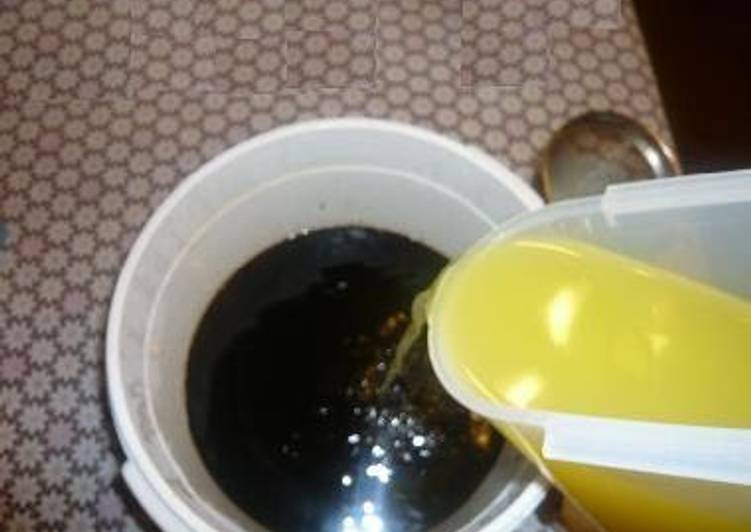How To Make Ponzu Sauce Our Way. Because of its versatility & refreshing flavor, you can use the sauce in many different ways. Enjoy ponzu as a dipping sauce for shabu-shabu or seafood, as a marinade for grilled meats and vegetables or dressing for salads or. Today, I want to share with you my Ponzu sushi makes wonderful aroma!
 Fresh homemade ponzu should last for at least a few days if kept I've never made a homemade ponzu sauce but I'm sure it is way better than what you buy.
Make Japanese ponzu sauce at home.
Visit our other Spruce sites *The % Daily Value (DV) tells you how much a nutrient in a food serving contributes to a daily diet.
You can Have How To Make Ponzu Sauce Our Way using 9 ingredients and 14 steps. Here is how you achieve that.
Fresh homemade ponzu should last for at least a few days if kept I've never made a homemade ponzu sauce but I'm sure it is way better than what you buy.
Make Japanese ponzu sauce at home.
Visit our other Spruce sites *The % Daily Value (DV) tells you how much a nutrient in a food serving contributes to a daily diet.
You can Have How To Make Ponzu Sauce Our Way using 9 ingredients and 14 steps. Here is how you achieve that.
Ingredients of How To Make Ponzu Sauce Our Way
- What You needis of The nikiri (simmered base):.
- It's 1 liter of Soy sauce.
- Lets Go Prepare 100 ml of Cooking sake.
- Lets Go Prepare 50 ml of Mirin.
- Lets Go Prepare 50 grams of Bonito flakes.
- It's 20 of cm Kombu.
- What You needis of Other ingredients:.
- Lets Go Prepare 1 liter of Sudachi (a citrus fruit) juice.
- Lets Go Prepare 200 ml of Yuzu juice.
Ponzu can be used in many different ways. It's often used as a condiment or dipping sauce. For an easy supper that you can depend on, we picked out some of our tried-and-true favorites that have gotten us through even the busiest of days. Toast the kombu and bonito flakes… Homemade Ponzu Sauce - citrusy, tangy, sweet, and salty, the perfect dressing, marinade or dipping sauce!
How To Make Ponzu Sauce Our Way instructions
- In a pot, boil the soy sauce, cooking sake, mirin and part of the konbu seaweed..
- Turn off the heat, add the bonito flakes and the rest of the konbu seaweed, and leave to rest overnight. This is nikiri..
- Wash the yuzu and sudachi. Spread them out to dry..
- Cut the citrus fruit in half and juice..
- It's a lot of sudachi juice. Transfer from the juicer to containers..
- When all the fruit are juiced, strain through a sieve to remove the seeds and pulp..
- The sudachi juice is a deep yellow. If there's too much sudachi in the ponzu, it will be very sour. If you wait until the sudachi is yellow and ripe it will be fruity..
- Yuzu juice is lightly colored and translucent..
- After letting it rest overnight, the bonito flakes and konbu seaweed in the nikiri will have sunk to the bottom..
- Drain the nikiri through a sieve to remove the konbu seaweed and bonito flakes..
- Add the citrus juices to the nikiri..
- Gently combine..
- Use a funnel to transfer the sauce to bottles. The bottles should be sterilized in boiling water and dried completely beforehand. If there's any moisture on the bottles, it may lead to mold growth..
- Dry-roast the leftover bonito flakes from making nikiri in a pan and turn it into furikake. The konbu seaweed can be cut up thinly, and simmered with sugar to make tsukudani..
Ponzu sauce is a savory sauce made for umami foods (Japanese for "pleasant savory taste.") Often served with sashimi, it also makes great marinades and Ponzu sauce is often used in umami dishes such as sashimi and shabu shabu. I've been using it for chicken marinade and grilling sauce and. Ponzu sauce is actually a little more complicated than that. The origin of ponzu is a mystery, but the name To make ponzu, these four ingredients are simmered together before the final star ingredient is added: citrus. It may be better off that way, of course, rather than being drowned out in bottles of.